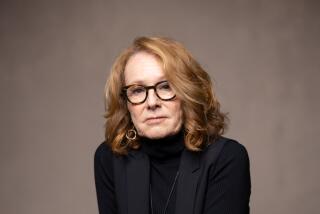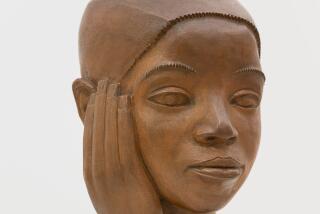‘Herstory’: Feminist art finds a home at Brooklyn Museum
- Share via
NEW YORK — Finally, feminist art has a gallery of its own. And then some.
The Elizabeth A. Sackler Center for Feminist Art, an 8,300-square-foot space specifically dedicated to examining the effect of feminism in the art world -- said to be the first museum space of its kind -- has taken up residence at the Brooklyn Museum.
The center, which opened March 23, is the brainchild of Sackler, who said that when she thinks of feminist values, she envisions “equality, equity, justice.”
“I see those values in feminism; those are part of what feminist art addresses,” she said in an interview.
“I think it’s a wonderful opportunity to work with the public, to engage in subjects in and around the history of women and the impact of women,” said Maura Reilly, curator of the center.
Sackler decided the centerpiece of the space would be an iconic work of feminist art, Judy Chicago’s “The Dinner Party,” from 1974-79. The large-scale installation has 39 place settings around a triangular table, with each setting representing a woman of historical note, from ancient goddesses to Georgia O’Keeffe. Tiles on the floor below the table are inscribed with the names of 999 women of significance.
The work, which has been displayed at the museum twice before, now takes up a permanent space in the center. A 300-square-foot “herstory” gallery is meant to work as an addendum, hosting exhibitions that focus on the women mentioned in Chicago’s work.
The first exhibit, “Pharaohs, Queens and Goddesses,” uses items from the museum’s extensive Egyptian collection to look at Hatshepsut, one of the few women to become ruler in Egypt, as well as other females in Egyptian history.
Another space is meant for changing exhibitions. The first one is “Global Feminisms,” a survey of contemporary feminist art featuring women from around the world.
The center also has space for public and educational programming.
Having a dedicated, permanent space for feminist art is a huge step forward from the occasional survey show or retrospective of a particular artist that museums have done, said Peggy Diggs, a senior lecturer in arts and humanities at Williams College in Williamstown, Mass.
“Shows have been good, but they come and go. They seem to always carry their hat in their hand, or else they look so retrograde, this kind of glimpse into the weird, weird past,” she said. “I’m hoping this will provide a much richer, deeper view.”
Sackler said she hoped the center would be a model that other museums would follow.
“For me, both feminism and feminist art is not the goal -- it’s the means toward an end. The end is equality,” she said. “Whether it’s equal pay or equal wall space, that’s the end.”
More to Read
The biggest entertainment stories
Get our big stories about Hollywood, film, television, music, arts, culture and more right in your inbox as soon as they publish.
You may occasionally receive promotional content from the Los Angeles Times.










